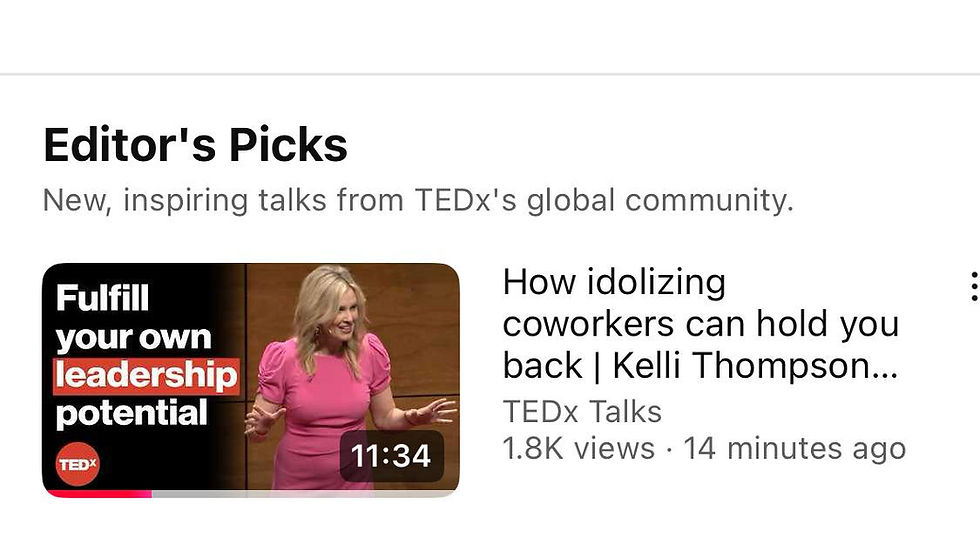Sneak Peek: Inspiration for my next book
- Kelli Thompson

- Jun 23
- 4 min read
Updated: Aug 25
TL;DR: An update on my next book and follow me over on Substack if you are there. I'll be testing/sharing some book insider updates.
Not long after my first book, Closing the Confidence Gap came out, I noticed a pattern in my coaching calls, especially with mid-level managers with Sr. Manager to Vice President level titles. (But let me be clear - I still coach C-Suite leaders on these tendencies, too!!). These were smart, reliable, high-achieving professionals who were consistently delivering results and had strong performance reputations inside their organizations.
And yet, they kept asking me the same questions:
“If I’m so good at my job, why am I not getting promoted?”
“I keep getting feedback that I need to get out of the weeds and be more strategic.”
“They keep telling me that I'm ‘indispensable but not executive material.’”
“I really want to lead well at this level, but when I'm not ”in the work" I feel confused on how I add value."
“How do I spend time ”being strategic?"
“I've never led teams in which I haven't done the work, and I feel like an imposter in not knowing the details of their challenges."
The more I heard these questions, the more I realized it was part of a trend. As these leaders advanced in the organization, the skills that earned them their early promotions could actually be skills that hold them back.
These weren’t underperformers. They were leaders who had outgrown their current roles, but couldn’t seem to break into the next level—no matter how hard they worked or how much value they added.
The big "a-ha this is a bigger thing" point for me came during a conversation with a client I’ll call Chris. She had trained half her department, carried the team through multiple leadership changes, and was the person her CEO called when things were on fire. Everyone described her as dependable. Essential. She was the we’d-fall-apart-without-her colleague. She’d been passed over twice for an executive role and title promotion. When I asked what feedback she received, she said, “They told me I’m not seen as strategic.”
“Be more strategic” is such a vague phrase. What does that even mean? Does that mean that you can no longer jump in to help? Does it mean that you lock yourself away in your office and design scenario plans? That advice might feel common and helpful, but sadly it isn't that actionable.
That situation was the spark for the course I launched two years ago (Advance From Doer to Leader) and now a book to follow (title still in the works!).
This book is meant to challenge the widely held belief that great performance leads to promotions. It doesn’t. In fact, being too good at your job can actually keep you stuck in it. You’re rewarded with more responsibility but not labeled as advancement potential. You become the fixer, the go-to, the one everyone counts on—until you look up and realize others, often with less experience, are passing you by.
I call this dynamic an advancement trap. It’s what happens when your best skills—your ability to solve problems, support others, stay dependable under pressure—become the very things that limit your growth. Not because those skills aren’t valuable, but because they keep you in execution mode. They keep you in the weeds. And eventually, they keep you invisible to the people making strategic decisions about your future.
The book (just like Closing The Confidence Gap) will never be about working harder, leaning in more, or fixing yourself. It’s about seeing the trap for what it is: a pattern rooted in how organizations reward productivity over potential, and how high achievers are conditioned to focus on what they can do instead of what they should stop doing. This book will focus on what you can stop doing and getting out of your own way (with practical tools, of course!).
I want the book to be filled with stories from leaders I’ve coached (my stories, too!), the mindset shifts they made, and the practical frameworks we used to help them stop over-functioning and start leading.
The idea builds naturally on the foundation of Closing the Confidence Gap. Once you believe in yourself, the next challenge is figuring out how to lead in a way that gets you seen and makes impact in the room where decisions are made.
If any of these things are a shift you’re trying to make—or you’re supporting others who are—you’ll see a lot of yourself in the stories and strategies I will be sharing here and testing on Substack.
I can’t wait to bring you along for the ride, but books take awhile! It's a practice in balancing ambition and patience. That's a fancy way of saying it likely won't be published until the end of 2026 or beginning of 2027.
—Kelli
PS: Because people ask, TL;DR stands for “too long, didn't read.” :)

Kelli Thompson is an award-winning author, keynote speaker, and executive coach who specializes in helping high achievers advance to influential leaders in their organizations. She is the author of the critically acclaimed book, Closing The Confidence Gap: Boost Your Peace, Your Potential & Your Paycheck.
Learn more about: Executive Coaching | Speaking & Training | Group Programs





Comments